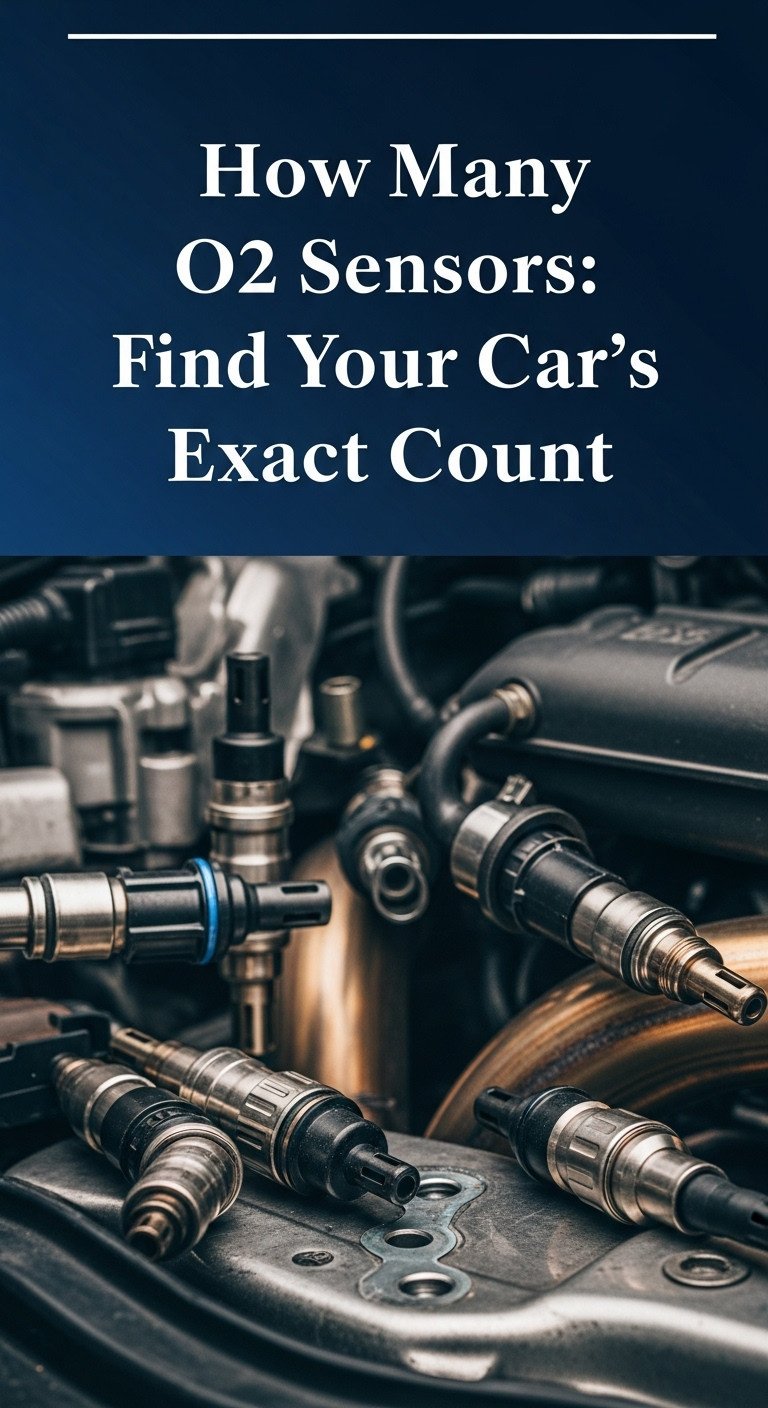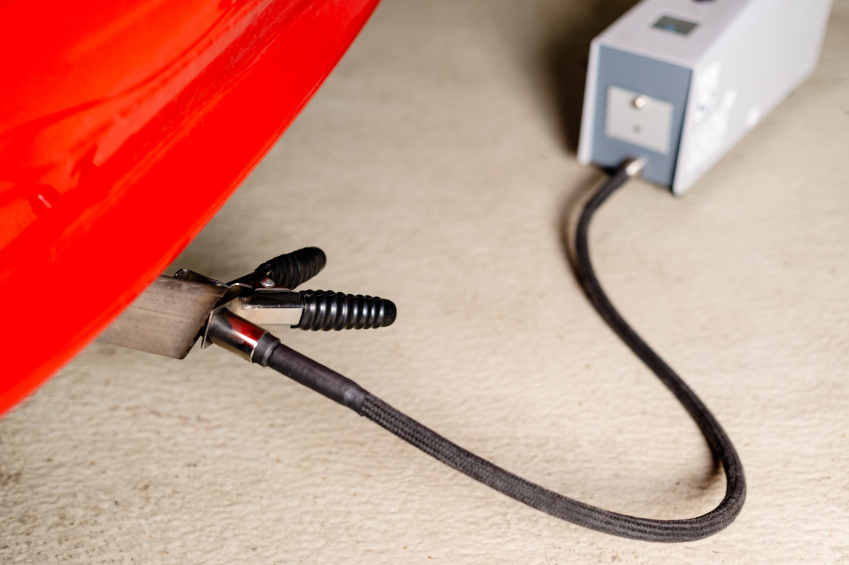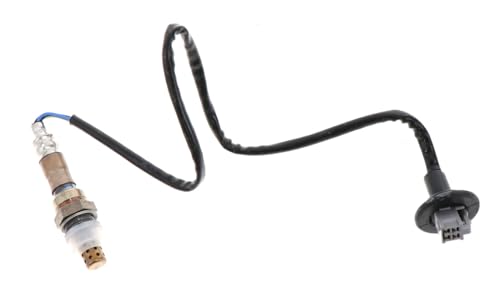Trying to figure out exactly how many O2 sensors are on your car can feel like a frustrating guessing game. You might hear different numbers depending on your engine size or vehicle year, leaving you unsure of the correct count before ordering parts or talking to a mechanic. This guide will definitively solve that problem.
The number of O2 sensors on a car almost always ranges from two to four for vehicles made after 1996. The precise count is determined by your vehicle’s engine type (e.g., 4-cylinder vs. V6), its model year, and the specific design of its emissions system.
Leveraging a deep analysis of automotive service data and emissions standards, this guide breaks down the exact factors that determine your car’s O2 sensor count. We’ll explore why a V8 has more sensors than a 4-cylinder and provide you with three foolproof methods to find the exact number for your specific vehicle.
Key Facts
- The 1996 Rule: According to Environmental Protection Agency (EPA) regulations, nearly every vehicle manufactured in or after 1996 is equipped with a minimum of two O2 sensors due to the On-Board Diagnostics II (OBD-II) mandate.
- Engine Configuration is Critical: V-style engines, such as a V6 or V8, typically have four O2 sensors because they have two separate exhaust “banks,” while inline engines usually have two sensors.
- Two Distinct Functions: Your car’s O2 sensors serve two different purposes. “Upstream” sensors fine-tune the air-fuel mixture for efficiency, while “downstream” sensors monitor the performance of the catalytic converter.
- A Simple Formula: The most reliable rule of thumb is that there is one upstream and one downstream oxygen sensor for every catalytic converter on the vehicle.
- Replacement Strategy Matters: While you only need to replace the one faulty sensor, automotive service professionals often recommend replacing them in pairs on higher-mileage vehicles, as they tend to age and fail at similar rates.
How Many O2 Sensors Does My Car Have? The Definitive Answer
Most cars made after 1996 have two to four O2 sensors. The exact count depends on the engine type, year, and emissions system.

This might seem like a wide range, but the variation is logical and directly tied to federal regulations and engine design. The most significant factor is the On-Board Diagnostics II (OBD-II) system, which became mandatory for all passenger vehicles sold in the United States starting in 1996. This system requires the vehicle’s computer to monitor the efficiency of the emissions system, which necessitated the addition of a second O2 sensor after the catalytic converter.
The bottom line is this: if your vehicle is from 1996 or newer, you have at least two oxygen sensors. If it has a V6 or V8 engine, you most likely have four.
But why isn’t there just one number for every car? Let’s dive into the key factors that determine the exact count for your vehicle.
Why the Number of O2 Sensors Varies: The 3 Key Factors
Your car’s O2 sensor count is determined by its engine type (4-cylinder, V6, etc.), its age (pre- or post-1996 OBD-II standard), and how many catalytic converters it has. Understanding these three elements will transform the question from a mystery into a simple process of elimination. As established by EPA standards, the entire system is designed for one purpose: to monitor and minimize harmful emissions as effectively as possible.
- Engine Configuration
- Vehicle Year & Emissions Standards
- Number of Catalytic Converters

Each of these factors plays a crucial role in the layout of the exhaust and emissions control system, directly dictating the final sensor count.
1. Engine Configuration: 4-Cylinder vs. V6 vs. V8
A 4-cylinder engine typically has two O2 sensors, while V6 and V8 engines commonly have four due to having two separate exhaust banks.
The shape of your engine is the single biggest predictor of your O2 sensor count. An inline engine, where the cylinders are in a straight line (like a typical 4-cylinder), has a single exhaust manifold collecting all the exhaust gases. This single “exhaust bank” requires only one upstream sensor to monitor the air-fuel ratio and one downstream sensor to monitor the catalytic converter.
A V-engine (like a V6 or V8) has two separate banks of cylinders arranged in a “V” shape. Each bank has its own exhaust manifold. To properly control the air-fuel mixture, each bank needs its own dedicated upstream O2 sensor. Consequently, this setup almost always requires two downstream sensors as well, leading to a total of four.
This is a standard design principle outlined in Automotive Service Excellence (ASE) training materials. The vehicle’s computer needs to read and adjust each bank of cylinders independently for optimal performance and emissions control.

Here’s a simple breakdown:
| Engine Type | Typical Upstream Sensors | Typical Downstream Sensors | Total Sensors |
|---|---|---|---|
| Inline-4 Cylinder | 1 | 1 | 2 |
| V6 Engine | 2 (one per bank) | 2 (one per bank) | 4 |
| V8 Engine | 2 (one per bank) | 2 (one per bank) | 4 |
Pro Tip: If your engine cover looks like a ‘V’, you almost certainly have at least four O2 sensors.
2. Vehicle Year & Emissions Standards (The OBD-II Rule)
Vehicles made in 1996 or later have at least two O2 sensors due to OBD-II standards requiring monitoring of the catalytic converter.
The year 1996 is a pivotal date in automotive technology. This was when the OBD-II (On-Board Diagnostics II) mandate, developed by organizations like SAE International and enforced by the EPA, became law for all cars and light trucks sold in the U.S.
Before 1996, vehicles might have had only one O2 sensor (or sometimes none at all). Its sole job was to help the engine computer adjust the air-fuel mixture. There was no sensor to check if the catalytic converter was actually doing its job of cleaning the exhaust.
The OBD-II system changed everything. It required cars to be able to self-diagnose problems with the emissions system, including the catalytic converter. To do this, a second oxygen sensor was added after the converter.
The downstream (post-catalyst) sensor’s primary job is to measure the oxygen content exiting the catalytic converter. By comparing this reading to the upstream sensor’s reading, the engine’s computer can verify that the converter is working efficiently.
Quick Fact: This change is the main reason a check engine light can now tell you if your catalytic converter is failing, a feature that was impossible on most pre-OBD-II vehicles.
3. Number of Catalytic Converters
The general rule is one upstream and one downstream O2 sensor for every catalytic converter on the vehicle.
This factor ties directly into engine configuration. A simple inline-4 engine with a single exhaust pipe will have one catalytic converter. Following the rule, it gets one sensor before it and one sensor after it, for a total of two.
However, a V6 or V8 engine with a true dual exhaust system often has two separate pipes running from the engine to the back of the car. In many of these systems, each pipe will have its own catalytic converter. To properly monitor this setup, each of those converters needs its own pair of O2 sensors.
This results in the common configuration of four sensors:
* Bank 1, Sensor 1 (Upstream, passenger side)
* Bank 2, Sensor 1 (Upstream, driver side)
* Bank 1, Sensor 2 (Downstream, passenger side)
* Bank 2, Sensor 2 (Downstream, driver side)
The simple formula to remember is: 1 Catalytic Converter = 1 Upstream + 1 Downstream Sensor.
How to Find Your Car’s Exact O2 Sensor Count
Ready to get a definitive answer? While the rules above give you a very accurate estimate, these three methods will give you the precise count for your specific make, model, and engine.
- Check Your Owner’s Manual or a Service Manual: This is the most authoritative source. Check the index for “Oxygen Sensor,” “O2 Sensor,” or “Emissions System.” The manual will often have a diagram or description specifying the number and general location of the sensors.
-
Use an Online Parts Catalog (The Easiest Method): Websites like RockAuto or the online portals for AutoZone and NAPA Auto Parts are incredibly useful. Enter your vehicle’s exact year, make, model, and engine size. Navigate to the “Exhaust” or “Emission” category and find “Oxygen (O2) Sensor.” The catalog will list all the available sensor positions for your car (e.g., “Upstream Left,” “Downstream Right,” etc.). Simply count the number of unique positions listed to find your total.
-
Perform a Visual Inspection: If you’re comfortable looking under your vehicle, you can trace the exhaust system. Start at the engine’s exhaust manifolds. You will see a sensor (it looks like a spark plug with a wire coming out of it) screwed into the pipe before the catalytic converter—that’s the upstream sensor. Look for another sensor after the catalytic converter—that’s the downstream one. If you have a V-engine, be sure to check both sides of the engine for two identical setups.
https://www.youtube.com/watch?v=eiY1fHcDqu0&pp=ygUII3QwMDU3NWE%3D
To accurately diagnose which sensor is faulty, a reliable OBD-II scanner is an indispensable tool for any DIY mechanic.
FAQs About Your Car’s O2 Sensors
Here are answers to the most common follow-up questions about identifying and replacing your vehicle’s oxygen sensors.
How do I know how many O2 sensors I have without looking?
Use an online parts lookup tool (like RockAuto or AutoZone) with your vehicle’s exact details to see all listed O2 sensor positions. This is the fastest and most reliable method without getting under the car. Follow these simple steps:
1. Navigate to a reputable online auto parts retailer.
2. Enter your car’s year, make, model, and specific engine (e.g., 3.5L V6).
3. Go to the “Emission” or “Exhaust” parts section and click on “Oxygen Sensor.”
4. The website will display all the sensors that fit your vehicle, labeled by position, such as “Upstream,” “Downstream,” “Bank 1 Sensor 1,” etc. Counting these unique positions gives you your exact total.
Should I replace all O2 sensors if one is bad?
While not required, it is often recommended to replace O2 sensors in pairs or all at once on older vehicles, as they tend to fail around the same time. You are only technically required to replace the single sensor that has failed. However, there are compelling reasons to consider replacing more than one, especially on a high-mileage vehicle.
- Pros of Replacing Just One:
💲Lowest immediate cost.
- Pros of Replacing in Pairs/All at Once:
✅Prevents future failures. O2 sensors age at a similar rate, so if one has failed, others may be close behind.✅Ensures balanced performance. A new sensor will react faster than an old one, and having mismatched sensors on different engine banks can cause subtle performance issues.✅Saves on future labor costs by doing the job once.
Many experienced mechanics suggest replacing upstream sensors as a pair to keep engine bank readings balanced.
How can you tell which O2 sensor is bad?
The most reliable way to tell which O2 sensor is bad is to use an OBD-II scanner, which will provide an error code identifying the specific sensor’s location.
1. Use an OBD-II Scanner: This is the standard method. Plug the scanner into your car’s port (usually under the steering wheel) and read the Diagnostic Trouble Codes (DTCs). A code like “P0135” indicates a problem with the “O2 Sensor Heater Circuit (Bank 1, Sensor 1),” telling you exactly which sensor is faulty.
2. Analyze Live Data: A more advanced scanner can read live data. According to diagnostic information found in SERP analysis, one trick mechanics use is to observe sensor readings during full-throttle acceleration. Both upstream and downstream sensors should read “rich.” If the upstream sensor reads “lean” while the downstream reads “rich,” the upstream sensor is very likely the one that has failed.
How much do O2 sensors cost to replace?
Expect to pay $20-$100+ for the O2 sensor part itself, and a total of $100-$300 for professional replacement including labor. The cost can vary widely based on your vehicle and the sensor’s location, as some are much harder to access than others. Here is a general cost breakdown as of 2025:
- Part Cost: A universal-fit O2 sensor can be as little as $20, while a direct-fit, original equipment (OE) sensor for a luxury or performance vehicle can cost over $100.
- Labor Cost: A mechanic will typically charge for 30 minutes to one hour of labor.
- Total Professional Cost: Including parts and labor, you can expect the total to be in the $100 to $300 range per sensor.
Final Summary: Nailing Down Your O2 Sensor Count
Figuring out how many O2 sensors are on my car is straightforward once you know the three determining factors: your engine type, your vehicle’s year, and the number of catalytic converters. For most drivers of vehicles made after 1996, the answer will be two or four. A V-shaped engine almost always means four sensors, while a straight engine usually means two.
Now you have the knowledge to find your exact sensor count and understand why it matters.
- Remember the OBD-II Rule: If your car is 1996 or newer, it has at least one upstream and one downstream sensor.
- Engine Shape is Key: Inline engines typically have two sensors; V-engines have four.
- Use Online Tools: The fastest way to get a certain answer is to look up your vehicle on an online parts catalog like RockAuto.
Use the methods above to get your definitive answer and take control of your next auto repair project
Last update on 2025-11-26 / Affiliate links / Images from Amazon Product Advertising API













